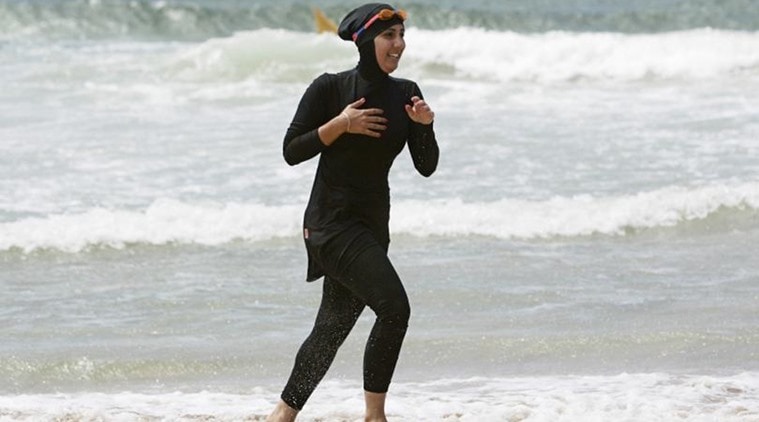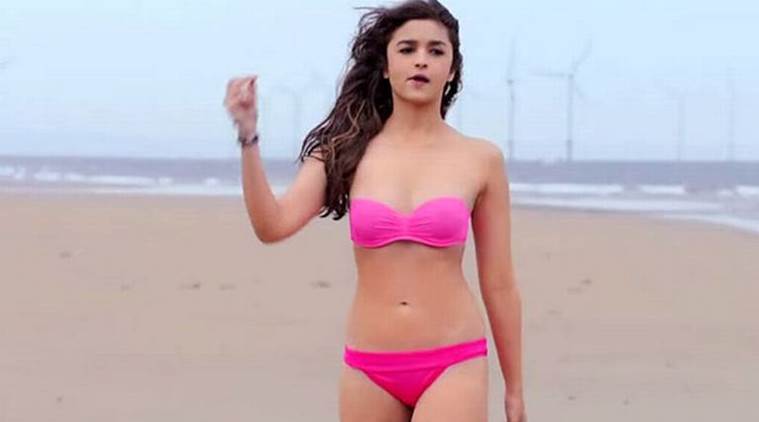📣 For more lifestyle news, click here to join our WhatsApp Channel and also follow us on Instagram
International Bikini Day 2019: How burkini continues to spark gender debates across world
Originally designed in 2004 by Aheda Zanetti, a Lebanese-born Australian fashion designer, a burkini is a play on two words — burqa, which is a body and head covering garment worn by Islamic women in public, and bikini.
 Burkini reveals only the face, hands, and feet and allows women to take part in water activities. (Source: File Photo)
Burkini reveals only the face, hands, and feet and allows women to take part in water activities. (Source: File Photo)
The debate over burkini or full-body swimwear was re-ignited in France last week with a group of Muslim women entering a public pool in Grenoble wearing the garment in defiance of a municipal ban. The pool mandates women to wear bikinis or one-piece, while burkinis cover a woman’s arms and legs revealing only their face, hands, and feet. The women, who called themselves ‘Muslim Rosa Parks’ after the American civil rights activist, were eventually thrown out and fined; the pool was closed for two days even as temperatures in the city soared to a record high.
This International Bikini Day, which is celebrated on July 5, let’s take a look at the burkini’s origin, its rise and how it remains at the centre of heated debates, especially in France where all forms of the veil have always triggered tensions.
Designed for comfort but raises eyebrows
Originally designed in 2004 by Aheda Zanetti, a Lebanese-born Australian fashion designer, a burkini is a play on two words — burqa, which is a body and head covering garment worn by Islamic women in public, and bikini. It was essentially designed so that Muslim women, who choose to wear a head cover like the hijab, could participate in water activities and other sports.
Neither looking like a burqa nor a bikini, the swimwear rather resembles wetsuits with a hood attached. Burkini was popularly in headlines when, a few years ago, English TV personality and food and gourmet writer Nigella Lawson wore the “modesty-covering” burkini on Australia’s Bondi beach to protect her skin from the sun, according to a report by The Telegraph.
The designer reportedly said, “I hope that they understand that it’s not something that symbolises anything – that anyone can wear it, that it’s not harming anything in any way. The burkini was designed for freedom, flexibility and confidence. It was designed to integrate into Australian society,” she said, adding, “I don’t understand why a piece of fabric is taking over all of these really important issues?”
Zanetti had reportedly designed burkini to cheer her niece, who was playing netball wearing something totally inappropriate for a sports uniform — a skivvy, tracksuit pants, and her hijab. She then decided to launch a sportswear for Muslim women so they don’t feel restricted.
Zanetti had also told a news agency that they have sold burkinis to not just only Muslim women but also to Jews, Hindus, Christians, and those women with body issues. Zanetti’s designs, however, aren’t the only option — many brands based around the world now make burkinis.
In March 2016, popular British retailer Marks and Spencer began selling burkinis to appeal to women across countries and the swimsuits started flying off the shelves and came into the mainstream. More and more Muslim women took a shine to the garment — which, they said, was covering yet liberating simultaneously.
Rio Olympics 2016
Athletes at the Rio Olympics 2016 wore the burkini while participating in events. Doaa Elghobashy from Egypt who played beach volleyball in a burkini made headlines for her attire than for her aptitude at the game. Kariman Abuljadayel, first Saudi Arabian woman to compete in the 100m event, also wore a similar attire.
Burkini and Europe
In 2016, a number of cities in France debated banning the burkini, arguing that the body-covering swimwear wasn’t in line with France’s secular views. France’s highest court ultimately ruled in 2016 that a burkini ban was unconstitutional.
Geneva banned burkinis in 2017. But owing to the defenders of the garment in Europe, a school in Germany purchased burkinis for students to wear in swim class in 2018. Some lawmakers protested, but a minister supported the school’s decision.
Somali American model Halima Aden’s burkini photoshoot
Halima Aden, a Somali American and Muslim model, became the first woman to pose in a burkini for American magazine Sports Illustrated‘s swimsuit issue earlier this year. The magazine received mixed reactions with several people expressing dismay while others appreciated her move.
Halima made headlines at age 19 when she was the first woman to wear a hijab in the Miss Minnesota USA Pageant, where she made it to the semi-finals in 2016.
Whether it is the burkini, bathing suit, beachwear or bikini, each of them have had their own history and continue to spark debate from time to time.
Here is a quick lowdown on other types of swimwear.
Bandeau Top
 Alia Bhatt from ‘Shaandaar’ rocked the bandeau top look. (Source: File Photo)
Alia Bhatt from ‘Shaandaar’ rocked the bandeau top look. (Source: File Photo)
Usually a strapless top, bandeau bikini tops usually comprise of a portion of fabric that covers the bust area. They may sometimes include straps to help offer extra stability and support.
Triangle Top
The triangle top is a classic, timeless bikini top that has always been in vogue. The triangles slide along the bottom string so that one can adjust the coverage as needed.
One-Shoulder Top
An asymmetrical bikini, the one-shoulder top has a strap going over only one shoulder.
Tie-Front Bikini Top
Instead of tying your bikini behind your neck and at your back, you can tie these in the front!
Sport Top
A two-piece top that looks just like a sports bra works well for swimming laps or generally being active in water.
High-Neck Bikini
High-neck suits fit closely to the neck and don’t plunge.
Longline Bikini Top
This cut of suit has a crop top like feel, hitting a little lower on the rib cage than most other bikinis.
One-Piece
Basically, a suit that covers your top and bottom in just one piece.
Monokini
Monokinis are a hybrid of one- and two-piece swimsuits.
Sport suit
 A sport suit helps to make the perfect laps in water. (Source: File Photo)
A sport suit helps to make the perfect laps in water. (Source: File Photo)
Perfect for water activities, this suit helps because of its ability to stay in place and be aerodynamic.
Cheeky-Cut Bottoms
This bikini bottom style is perfect if you want to make your legs seem longer and show off a bit of skin.
Side-Tie Bikini Bottoms
This bikini bottom has straps on the side, making it easy to adjust. This is the perfect bikini bottom style when you want to tan as it will give you less tanlines.
Boyshort Bottoms
Resembling shorts, they are great for sport activities like playing beach volleyball.
📣 For more lifestyle news, click here to join our WhatsApp Channel and also follow us on Instagram
- 01
- 02
- 03
- 04
- 05



























